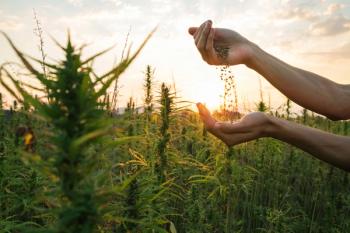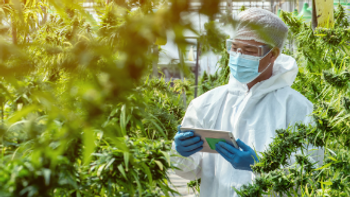
Cannabis Science and Technology
- October 2020
- Volume 3
- Issue 8
HVACD Controls for Plant Health, Product Quality, and Energy Efficiency in Cultivation and Drying Processes

Learn tips about monitoring environmental conditions to further improve yields.
Cultivating and drying cannabis involves maintaining target environmental conditions for optimal plant health and product quality, but growers using diverse heating, ventilation, air conditioning, and dehumidification (HVACD) systems experience different challenges with achieving and keeping spaces within target ranges. Infrastructure used to control these HVACD systems (HVACD controls) can vary in level of sophistication, which can affect plant growth and yield during cultivation, and flower aroma and appearance while product is drying and curing. Understand how building construction, HVACD equipment, and controls setpoints can affect your crop and operating expenses and learn tips about monitoring environmental conditions to further improve yields.
Maintaining target environmental conditions while you cultivate, dry, and cure cannabis is critical to ensuring optimal plant health and product quality. As cannabis grows, transpiration and yield can be maximized using heating, ventilation, air conditioning, and dehumidification (HVACD) equipment to control temperature and humidity. Likewise, as cannabis is dried and cured, to speed up the process while preserving terpene and tetrahydrocannabinol (THC) content, aroma, and appearance, you can maintain target conditions using diverse types of HVACD equipment.
You can use simple and sophisticated HVACD systems with varying levels of success. In this column, we explore your options for equipment and controls, how selection of temperature and humidity targets can affect your crop and operating expenses, and how monitoring environmental conditions can further improve yields.
Speaking the Same Language
To discuss the characteristics of HVACD systems, it is useful to understand the key terms related to heating, cooling, air conditioning, and dehumidification in cultivation facilities, their units of measurement and how they are used, why the terms are important to consider as a cultivator, and how the terms may be commonly misunderstood or misapplied.
As a non-profit advocacy organization, Resource Innovation Institute (RII) cultivates resource efficiency for a better agricultural future, and part of their mission includes providing objective, brand-agnostic education to the cannabis industry. In 2019, after a collaborative process involving 25 expert contributors and 29 peer reviewers, RII published two Best Practices Guides including HVAC for Cannabis Cultivation and Controlled Environment Agriculture (1). Download the free guide to learn standardized terms and definitions for HVACD systems; assembling effective project teams; how to review manufacturers’ literature; crucial considerations when selecting equipment; and how to install and operate successful HVACD solutions in alignment with business models. RII's goal is to empower cultivators to achieve greater operational efficiencies in their cannabis business.
Capabilities of HVACD Systems
There are many ways to manage the heat and moisture you want to remove from your growing, drying, and curing spaces of your greenhouse or indoor cultivation facility. The capability of your HVACD equipment to meet and maintain your target environmental conditions will vary depending on the building in which you grow, dry, and cure, the HVACD systems you choose, and the way you control them.
HVACD Controls Approaches for Cultivation
Greenhouses and indoor facilities involve different kinds of building construction. Infiltration—the intrusion of outdoor air inside buildings—is higher in ventilated greenhouses and lower in sealed greenhouses and indoor cannabis cultivation operations. Higher infiltration makes most greenhouses more sensitive to outdoor temperatures and humidity levels. Differences in building construction lead to different HVACD equipment being used in the two major types of cannabis cultivation approaches.
Cultivators experience different challenges with achieving and keeping spaces within target ranges when using different HVACD systems to maintain environmental conditions during cultivation and drying processes. Infrastructure used to control these HVACD systems can vary in level of sophistication, which can affect plant growth and yield during cultivation, and flower aroma and appearance while product is drying and curing.
HVACD Equipment and Controls in Ventilated Greenhouses
In greenhouses with high levels of infiltration, HVACD equipment for controlling temperature and humidity can be simple. In colder climates, greenhouses use mostly fuel-based hydronic (water-based) or convective (air-based) heating systems (2). To cool greenhouses, end wall ventilation fans and roof vents can be operated in stages, and you might have evaporative cooling wall systems installed on the opposite wall of ventilation fans for more cooling capacity. Dehumidification equipment is not commonly employed, and you might use ventilation equipment or roof vents to reduce humidity.
In many ventilated greenhouses, ventilation and cooling systems are operated manually. You can use automation systems to monitor environmental conditions and operate fans, roof vents, and cooling equipment in stages to improve plant health and avoid crop loss. Without more advanced HVACD controls systems, ventilated greenhouses struggle to achieve target environmental conditions (3).
HVACD Equipment and Controls in Indoor Facilities and Sealed Greenhouses
In indoor cultivation spaces and high-performance greenhouses with low levels of infiltration, you have a greater capability of controlling temperature and humidity with more complex and sophisticated HVACD equipment.
Indoor operations can use split direct expansion systems, electric and gas-fired chillers, geothermal systems, standalone portable dehumidifiers, de-coupled centralized desiccant systems, and integrated HVAC and dehumidification systems. You may choose to control humidity separately from temperature, or can manage both simultaneously for zones of grow rooms or your entire building using an integrated HVACD system.
HVACD systems for indoor cannabis cultivation are often controlled with automation systems that are more capable of balancing and meeting loads of your spaces and can offer a higher degree of environmental control than the simpler equipment used in greenhouses. Since your building is less sensitive to ambient temperature and humidity levels, your HVACD equipment is also more capable of achieving target environmental conditions.
HVACD Approaches for Drying and Curing
Cannabis can be dried in several kinds of buildings, including barns, greenhouses, and indoor facilities. Infiltration is higher in barns and greenhouses, and lower in indoor cannabis drying operations. The common approaches to drying can be categorized in three process categories: ambient, heating, and dehumidification. Differences in building construction, final cannabis product, and desired drying time lead to different HVACD equipment being used in drying operations.
Ambient Equipment and Controls for Drying and Curing
In barns and greenhouses with high levels of infiltration, you can hang your cannabis flower in a barn or lay it out on greenhouse benches to dry using the outdoor air. Fans for ventilation and circulation of air may be the only HVACD equipment you employ to move moisture out of your drying shed.
Ambient approaches to drying and curing are more sensitive to changes in outdoor conditions. Daily temperature and humidity fluctuations can impact drying time and product quality without thoughtful air circulation and ventilation to achieve and maintain target environmental conditions throughout the drying process.
Heating Equipment and Controls for Drying and Curing
You may choose to use heated air to dry your cannabis. Heated drying equipment like plenum or rotary driers can use a variety of fuel sources and be sized to fit your harvest. These systems can be packaged tobacco driers or custom-built on-site for cannabis drying.
These systems also can offer electronic environmental setpoints so you can choose higher drying temperatures for quicker drying times, or modulate to lower temperature setpoints to avoid damaging trichomes or affecting appearance.
Dehumidification Equipment and Controls for Drying and Curing
Indoor facilities with low levels of infiltration might use equipment with a refrigeration cycle, such as dehumidifiers or heat pumps, to remove moisture from drying rooms. These systems cool air to remove moisture and some heat pump systems can be reversed to heat or cool depending on the application.
Dehumidification systems can offer more sophisticated environmental control at lower temperatures than heated drying equipment that may be desired for craft cannabis curing processes.
Choosing and Monitoring Target Environmental Conditions
Greenhouses and indoor facilities pose different challenges to achieving target conditions due to differences in infiltration, HVACD equipment employed, and sophistication of HVACD controls.
How you use the types of HVACD systems serving your cannabis operation matters. Whether you grow or dry cannabis in a greenhouse or indoors, the targets you choose for environmental conditions in grow rooms and drying areas can affect your crop and operating expenses. Resource efficiency has a direct impact on your profit and only the best operators will survive in this competitive market (4).
When considering target environmental setpoints for temperature and humidity, think about how much energy you would like to use to produce your cannabis, and how quickly you would like to get things done. Choosing low temperature and humidity setpoints for cultivation can result in higher capital and operating costs as your HVACD equipment must be sized larger to handle your standard operating procedures and also uses more power and runs more often to meet your desired conditions. Similarly, choosing very high or very low temperatures to remove humidity from cannabis flower during drying and curing can also impact energy costs (5).
To make informed decisions, monitor environmental conditions in your existing cultivation and drying areas to determine your current operating procedure. Understanding how your rooms currently run will help you make adjustments to more energy-efficient setpoints. To track ranges of chosen setpoints and also measure yourself against your competition, consider benchmarking your energy consumption and cannabis production with a purpose-built tool for cultivation such as RII's Cannabis PowerScore (6) to evaluate how harvest count, flower yields, and production efficiency change over time as you tweak your environmental setpoints.
References
https://resourceinnovation.org/resources/#published-studies .https://assets.bouldercounty.org/wp-content/uploads/2020/05/EIOF-BC-Cultivation-Assessment-Summary-Report_Final-5_4_20.pdf .https://www.cannabisbusinesstimes.com/article/the-carbon-emission-impacts-of-greenhouse-cultivation/ .https://www.cannabisbusinesstimes.com/article/energy-efficient-cultivation-cannabis-resource-innovation-institute/ .http://magazine.cannabisbusinesstimes.com/article/june-2020/coy-approach-hvac-balancing-grow-environment-capex-opex-yield.aspx .https://cannabispowerscore.org/ .
About the Author
GRETCHEN SCHIMELPFENIG, PE, is the Technical Director of Resource Innovation Institute (RII) and manages the organization’s Technical Advisory Council. She is a professional engineer in California and Vermont, a home cultivator, and an energy efficiency expert. She authored the RII Best Practices Guides on HVAC and LED Lighting for Cannabis Cultivation and Controlled Environment Agriculture.
How to Cite this Article
G. Schimelpfenig, Cannabis Science and Technology 3(8), 14-16 (2020).
Articles in this issue
about 5 years ago
The FDA is Coming…Will the Cannabis Industry Be Ready? Part Iabout 5 years ago
Cannabis Cultivation: The New Agriculture Tech Playgroundabout 5 years ago
Integrated Data in Cannabis ERP: From Greenhouse to Productionabout 5 years ago
How to Rein in Cannabis Industry Energy?about 5 years ago
THC Remediation: A Basic UnderstandingNewsletter
Unlock the latest breakthroughs in cannabis science—subscribe now to get expert insights, research, and industry updates delivered to your inbox.



